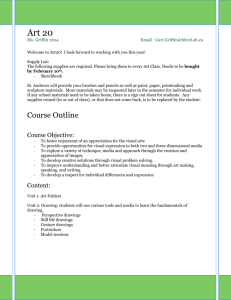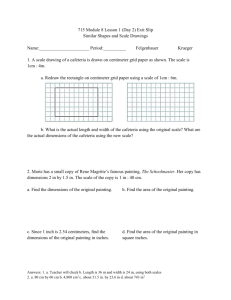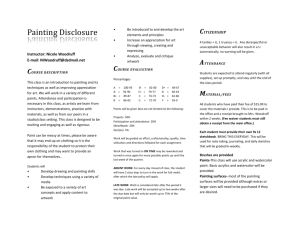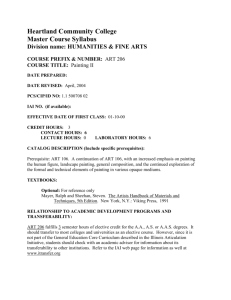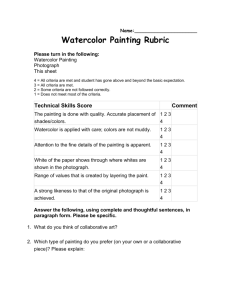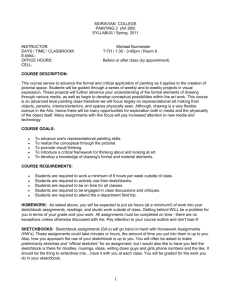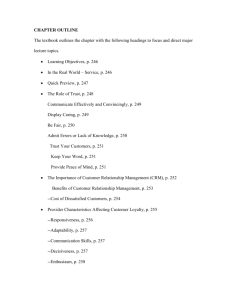View Syllabus
advertisement
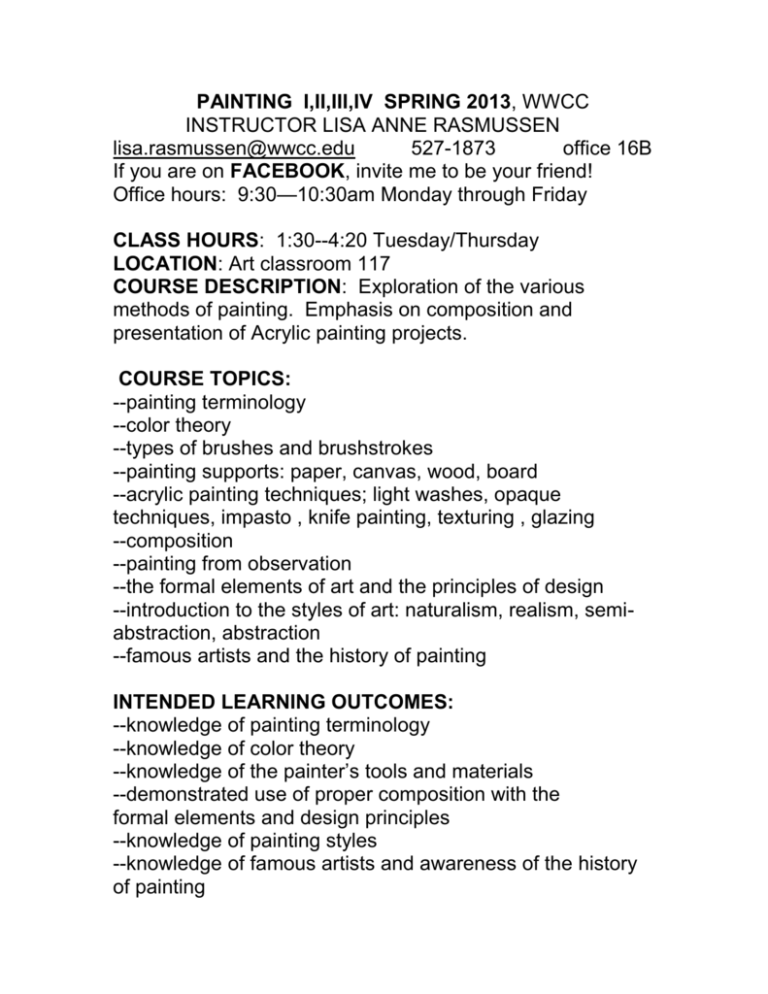
PAINTING I,II,III,IV SPRING 2013, WWCC INSTRUCTOR LISA ANNE RASMUSSEN lisa.rasmussen@wwcc.edu 527-1873 office 16B If you are on FACEBOOK, invite me to be your friend! Office hours: 9:30—10:30am Monday through Friday CLASS HOURS: 1:30--4:20 Tuesday/Thursday LOCATION: Art classroom 117 COURSE DESCRIPTION: Exploration of the various methods of painting. Emphasis on composition and presentation of Acrylic painting projects. COURSE TOPICS: --painting terminology --color theory --types of brushes and brushstrokes --painting supports: paper, canvas, wood, board --acrylic painting techniques; light washes, opaque techniques, impasto , knife painting, texturing , glazing --composition --painting from observation --the formal elements of art and the principles of design --introduction to the styles of art: naturalism, realism, semiabstraction, abstraction --famous artists and the history of painting INTENDED LEARNING OUTCOMES: --knowledge of painting terminology --knowledge of color theory --knowledge of the painter’s tools and materials --demonstrated use of proper composition with the formal elements and design principles --knowledge of painting styles --knowledge of famous artists and awareness of the history of painting TYPES OF INSTRUCTION: lecture, demonstration, video/DVD/youtube presentations, critiques, digital images, gallery field trips, survey of art books and hands on projects. TEXTBOOK: There is no textbook for this course. There will be a variety of art books available in the classroom. There will be some assigned reading of articles on the internet. EVALUATION DEVICES: Instructor Critique, Class Critique, Self Evaluation. ATTENDANCE: Attendance and class participation are a large part of your grade. This class only meets for 20 sessions. You are allowed one unexcused absence before your grade is affected. See the point system listed under grading. Should a family illness or emergency be the cause of your missing class, I am willing to make reasonable accommodations to help you make up the work. BUT IT IS THE STUDENT’S RESPONSIBILITY TO STAY IN CONTACT WITH ME BY PHONE OR E-MAIL. If you do not want your absences to affect your grade, you may do an extra gallery review to make up for every absence, or make up the exact number of hours in the studio. If you have another class that overlaps this one by one hour, I expect you to make up that time. The studio in 117 is open for Painting students 9:00am—1:30 and 3:30—5:00pm on MWF, and 9:00am—5:00pm on T/TH. ASSIGNMENTS: Enrollment is clustered to include students registered for Painting I, II, III and IV. Each group will receive a different assignment list. Four 18x24 paintings will be completed, with smaller studies to be done for practice. Everyone is required to keep a sketchbook/idea book. There will be some written assignments which will include vocabulary study guides, gallery reviews and short quizzes. GRADING: You will not be graded on your talent but on your effort. Your enthusiasm and willingness to participate in class activities are important to your grade. Beyond your one excused absence, you will loose ten points for every absence [unless you make up the studio time]. You will be given a grade on your portfolio at MIDTERM and at the FINAL. Your midterm portfolio will consist of all assignments done the first half of the quarter. There will also be a midterm critique. A writing sample may be included. Your final portfolio will consist of all the assignments we have done the second half of the quarter. There will also be a final critique. Progress reports will be given as needed. Excessive tardiness or failure to listen during lectures and demonstrations will affect your grade. POINT SYSTEM: 20 classes worth 10 points each = 200 Midterm Portfolio worth 100 Final Portfolio worth 100 Total Possible: 400 A AB+ B BC+ C CD+ D DF 93-100% 90-92% 88-89% 83-87% 80-82% 78-79% 73-77% 70-72% 68-69% 63-67% 60-62% 0-59% 368-400 358-367 350-357 330-34 318-329 310-317 291-309 278-290 270-277 251-269 238-250 001-237 EXPECTATIONS OF STUDENTS: Students will.... 1. become more VISUALLY AWARE 2. be RESPECTFUL of the teacher and your peers 3. be GOOD LISTENERS [do not use cell phones in class] 4. ASK QUESTIONS if confused 5. show EVIDENCE OF LEARNING OUTSIDE THE STUDIO 6. INVEST THEIR TIME 7. TAKE CREATIVE RISKS 8. VERBALLY PARTICIPATE in DISCUSSIONS and CRITIQUES 9. learn TO TALK LIKE AN ARTIST 10. THINK ABOUT ART in a larger context than the studio 11. MAKE THE MOST OF CLASS TIME [this includes showing up on time and staying for the whole class] 12. Be a TEAM PLAYER and contribute to the learning environment by completing class assignments on time and helping to clean-up DISABILITIES ACCOMMODATIONS: To request accommodations related to a disability, contact Claudia Angus, Ph.D., Coordinator of Disability Support Services, at 527-4262 or email claudia.angus@wwcc.edu PAINTING SUPPLIES: Heavy Paper for experiments [watercolor paper, or Bristol board, or acrylic paper] Sketchbook 9 x 12 or larger Canvas, 4 that are 18 x 24 and other assorted sizes ACRYLIC PAINTS in tubes are required in the following colors: Cad Red Medium Cad Yellow Medium Ultramarine Blue Phthalo Green Cad Red or Red Light [other names for orange] Deep Violet or Dioxanine Purple White Black I recommend an a COLOR THEORY Set [this includes Titanium White, Mars Black, Cad Red Medium, Cad Yellow, Ultramarine Blue and Phthalo Green] BRUSHES: our bookstore carries the Connoisseur Brand. They come in a variety of sizes and all are good to work with, but these are the ones I recommend that you will use the most: #1 Connoisseur Bright [262-1] #6 Connoisseur Bright [262-6] #2 Connoisseur 267 White Taklon Round 1 inch Connoisseur 107 Taklon Mix SQ Wash or #12 Flat PALETTE KNIVES POCKET COLOR WHEEL PAINT PALETTE: You may purchase a palette to mix paints on or you may bring an old plate or plastic plate from home. Plates can be stored in Ziploc bags. SKETCHBOOKS / IDEA BOOK You will use your sketchbook as a place to practice, gather and store your ideas. There will be sketchbook assignments, due dates given. Some supplies will be provided in class. Different prices will be discussed for students concerned about high costs. Do not drop the class if you are afraid you cannot afford the supplies. CLASSROOM BEHAVIOR: Our goal is a high quality, collegiate environment that encourages learning. Let us work toward that in a courteous manner. Disruptions to our learning environment will not be tolerated. Repeated instances of disruptive behavior will likely result in student dismissal from the course. Any electronic devices that might disturb the class such as cell phones and pagers. The instructor will occasionally play music for the class to work by. If students wish to listen to their own music while working, they must wear headphones. CLEAN-UP: The last ten minutes of each class is reserved for clean up. Each student is expected to participate. Failure to do so will affect your grade. This includes: emptying paint water is designated containers; putting away supplies your borrowed from the room; putting away your own supplies in your locker; washing off your table; cleaning up any paint spilled on the floor.
